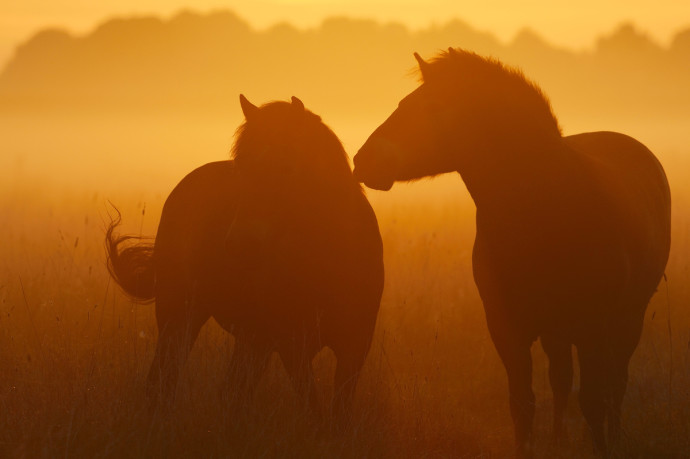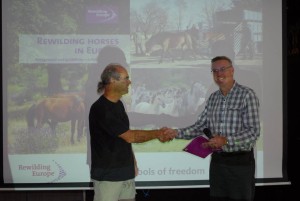Rewilding Europe today launched its new study “Rewilding horses in Europe”. It is the first of its kind on this exciting topic, providing the necessary background information as well as practical guidelines.

This well illustrated, 48-page study was presented at the Eurosite workshop “Living with wilderness” in Haarlem, The Netherlands on September 17, by Rewilding Director Wouter Helmer. The first report was handed over to David Parker, Board Member of Eurosite.
The European wild horse is strangely enough both extinct and at the same time still present. Officially it is extinct since the early 1900s, but at the same time its genome is not lost and still exists across several types of old, original horses: from Exmoors in the west to Huculs in the east of the old continent.

”This document guides the reader through the rich world of European horse types, makes a first selection of which horses that are suitable for rewilding and then gives guidance on how to rewild horses in the best possible way, according to the latest scientific and practical knowledge”, says Frans Schepers, Managing Director of Rewilding Europe. ”Since this kind of knowledge is developing rapidly, this document must first and foremost be seen as a living document and this is also how Rewilding Europe will use it. It reveals our practical experiences from rewilding horses in different ecosystems in Europe and at the same time presents the latest scientific research finds. With it, we hope to contribute to an ultimate rewilding goal: well-functioning European ecosystems, with the full range of keystone wildlife species present, and the wild horse being one of them”.
Several primitive horse types still have many of the characteristics and genetics from the original wild horse and are very fit for rewilding, regaining their rightful place in the European ecosystems: The Exmoor pony for Northwest Europe and England, with possibilities to add the Dartmoor and Welsh ponies to restore genetic diversity or the Eriskay pony in harsher climates; the Yakut pony for harsh climates in Northernmost Europe and Siberia; the Konik Polski from Latvian or Dutch/Belgium free ranging herds in the lowland areas of Northern/Central Europe (Netherlands, Belgium, Northern France, Germany, Poland and the Baltics); theHucul in the Central and Eastern European mountains, ranging into the Alps; the Pottoko can be used in the mountains of South-Western Europe, such as France, Spain and Portugal; the Asturcon, Losino, Monichino, Cabalo Galego/Faco or Garrano/Minho/Geres can be mixed to improve genetic diversity as they have equal rewilding qualities and comparable characteristics. The long-legged Retuertas should be used in the more or less open steppe and dehesa areas of Central and Southern Spain; the Przewalski’s horse for the large East European continental steppes; and in the Balkans a number of ancient horse types are suitable, such as the Karakachan horse, the Bosnian and Serbian mountain ponies, the Myzegea horse and the Pindos pony/Thessalier.
Rewilding horses means to work towards a future wild horse and should not be mistaken with rebuilding extinct wild horses from the past. The rapidly growing knowledge about the many types of the extinct wild horse will be used to choose the right breeds and characteristics of existing horses for rewilding purposes.
Leo Linnartz from ARK Nature and Renee Meissner from Herds & Homelands are the authors of “Rewilding horses in Europe”. The report was made possible by a generous grant from the Liberty Wildlife Fund in The Netherlands.
